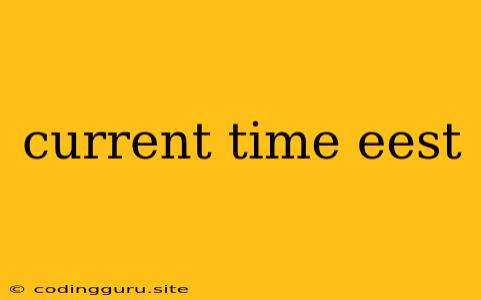Understanding and Working with EEST Time
The Eastern European Summer Time (EEST) is a time zone that is used during the summer months in several countries in Eastern Europe. It is three hours ahead of Coordinated Universal Time (UTC). Understanding how to obtain and work with the current EEST time is crucial for various applications, including:
- Scheduling and planning: Knowing the exact current EEST time is essential for scheduling meetings, appointments, and events across different time zones.
- Data analysis: Many datasets contain timestamps, and understanding the EEST time zone is critical for accurately analyzing and interpreting data.
- System integration: Applications that interact with systems in EEST time zone require accurate time information for proper functionality.
How to Determine the Current EEST Time?
There are multiple ways to determine the current EEST time:
-
Online Time Converters: Websites and applications dedicated to time conversions offer the most straightforward method. Simply search for "EEST time converter" online, enter your current time zone, and the converter will display the current EEST time.
-
Programming Libraries: Programming languages like Python, JavaScript, and Java provide libraries for time zone conversions. These libraries allow you to retrieve the current time in any desired time zone, including EEST, within your code.
-
Operating System Tools: Most operating systems include built-in tools to display and manage time zones. For instance, in Windows, you can access the "Date & Time" settings, which allows you to select different time zones, including EEST.
Working with EEST Time in Programming
Let's illustrate how to obtain and manipulate EEST time using a simple Python example:
import datetime
import pytz
# Create a datetime object for current time in UTC
utc_now = datetime.datetime.now(datetime.timezone.utc)
# Define the EEST timezone
eest_tz = pytz.timezone('Europe/Istanbul')
# Convert the UTC time to EEST
eest_time = utc_now.astimezone(eest_tz)
# Print the current EEST time
print(eest_time)
This code snippet imports the necessary libraries, creates a UTC datetime object, defines the EEST time zone, and then converts the UTC time to EEST. Finally, it prints the current EEST time.
Important Considerations
-
Daylight Saving Time: EEST is a daylight saving time zone, meaning it shifts by one hour during the summer months. It's essential to consider this shift when working with EEST time.
-
Time Zone Database: The accuracy of your time calculations relies on a reliable time zone database. Ensure that the library you are using (like pytz in the Python example) is up-to-date with the latest time zone information.
-
Format and Representation: Different applications and databases may store and display time data in different formats (e.g., ISO 8601, Unix timestamps). Be aware of these formatting differences when working with EEST time.
Conclusion
Obtaining and working with the current EEST time is crucial for various applications. Utilizing online time converters, programming libraries, or operating system tools can effectively manage and manipulate EEST time. By understanding the concepts of time zones, daylight saving time, and data formatting, you can ensure accuracy and consistency when dealing with EEST in your projects.
